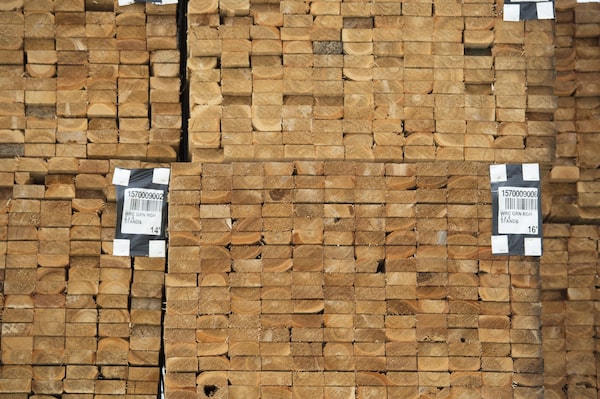
Fresh cut lumber is stacked at a mill along the Stave River in Maple Ridge, B.C. on April 25, 2019.JONATHAN HAYWARD/The Canadian Press
Lumber prices are soaring, driving big gains in the share prices of Canadian lumber producers so far this year. The best reason to stick with the rally rather than trying to time the top of the cycle: Stock prices aren’t reflecting all of the underlying good news yet.
While major benchmarks have been notching fresh record highs this year, lumber producers have been handily outperforming. Consider that West Fraser Timber Co. Ltd. has risen about 10 per cent in 2021, which is well ahead of the 4-per-cent gain in the S&P 500. Interfor Corp. is up nearly 16 per cent over the same period.
Part of the move is related to an infatuation with commodities and commodity producers, as investors bet that fiscal and monetary stimulus will translate into stronger global economic activity. Everything from copper to nickel and wheat to corn has been touching multiyear highs.
But the lumber market is rooted in current activity: Homebound consumers are building decks and home builders are particularly active in the United States.
U.S. housing starts in December show builders broke ground on nearly 1.7 million homes at a seasonally adjusted annual rate. That’s a 14-year high, driven largely by a 12-per-cent rise in single-family homes – a major source of lumber demand – as people flee congested cities and take advantage of record-low mortgage rates.
At the same time, the supply side of the equation is tight, as lumber producers struggle with a slow rollout of new sawmills. Underscoring efforts to increase supply, Interfor announced on Tuesday that it had reached an agreement to buy an existing sawmill in South Carolina for US$59-million, a week after the company beat analysts’ estimates for fourth-quarter profit.
“The biggest limitation right now is skilled labour. They’re using skilled tradesmen [at sawmills] now, and there is a real lack of them,” John Duncanson, timber analyst at Corton Capital’s Global Timber Fund, said in an interview.
He estimates that current demand for lumber requires about eight new U.S. sawmills a year, with British Columbia’s forestry sector operating flat-out while the busy spring building season hasn’t even begun. But the pace of new sawmills is lagging at about three or four a year.
The result: Western spruce-pine-fir lumber, a benchmark, rose to US$963 for every thousand board feet last week. That’s a new record high, eclipsing last year’s peak in September and more than double the highest price in 2019.
Can the good times last? If you’re worried about rising interest rates (which would raise mortgage rates and weigh on homebuilding activity), a slowing economy or an influx of supply that will create a lumber glut, you can easily build the case for cashing out.
But the bullish case is persuasive. Central banks have all but promised to leave interest rates at ultralow levels for some time, ensuring monetary stimulus continues as the global economy heals.
U.S. homebuilders want greater access to Canadian lumber to reduce supply constraints, and are appealing to U.S. President Joe Biden to end tariffs on Canadian lumber shipments to the United States.
What’s more, some analysts remain cautious, suggesting optimism hasn’t fully kicked in yet. Hamir Patel, an analyst at CIBC World Markets, last week raised his target price for where he expects lumber will trade this year by 30 per cent. But his new target, at US$650 for every thousand board feet, remains well below the current price.
“Even though we may be close to the peak, lumber prices aren’t going to come crashing down,” Mr. Duncanson said. “If you think the fourth quarter earnings are spectacular, wait until you see the current ones. I mean, we’re not even halfway through this quarter, but we know that Q1 is going to be better than Q4.”
Be smart with your money. Get the latest investing insights delivered right to your inbox three times a week, with the Globe Investor newsletter. Sign up today.